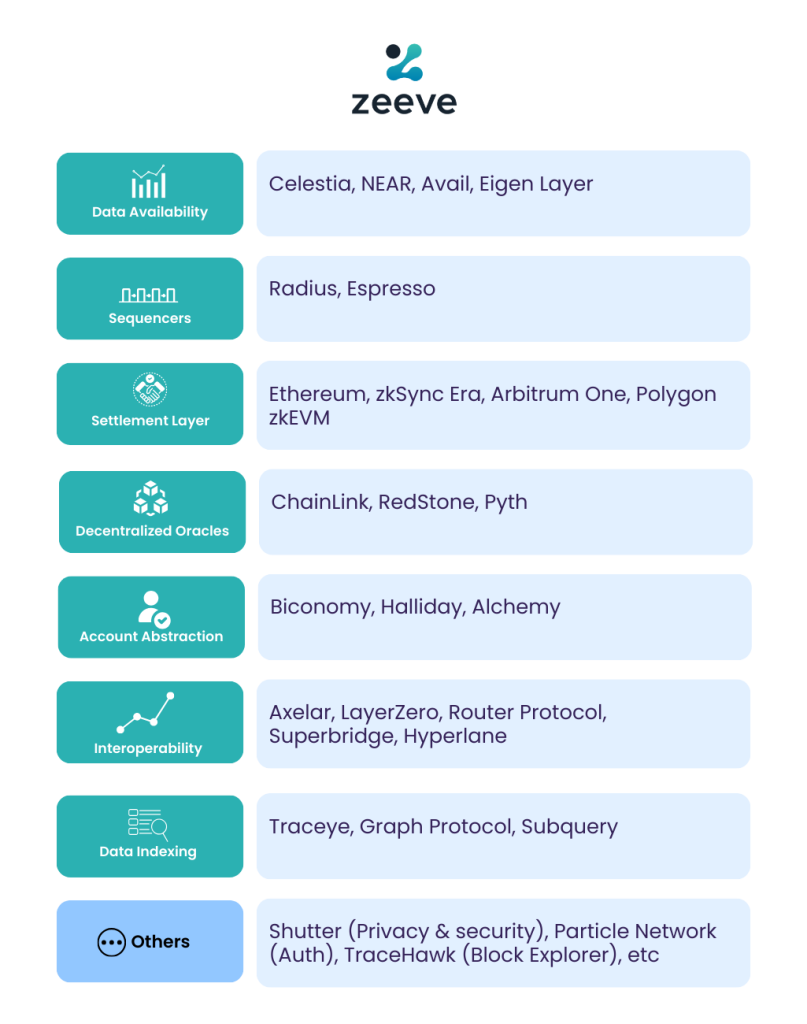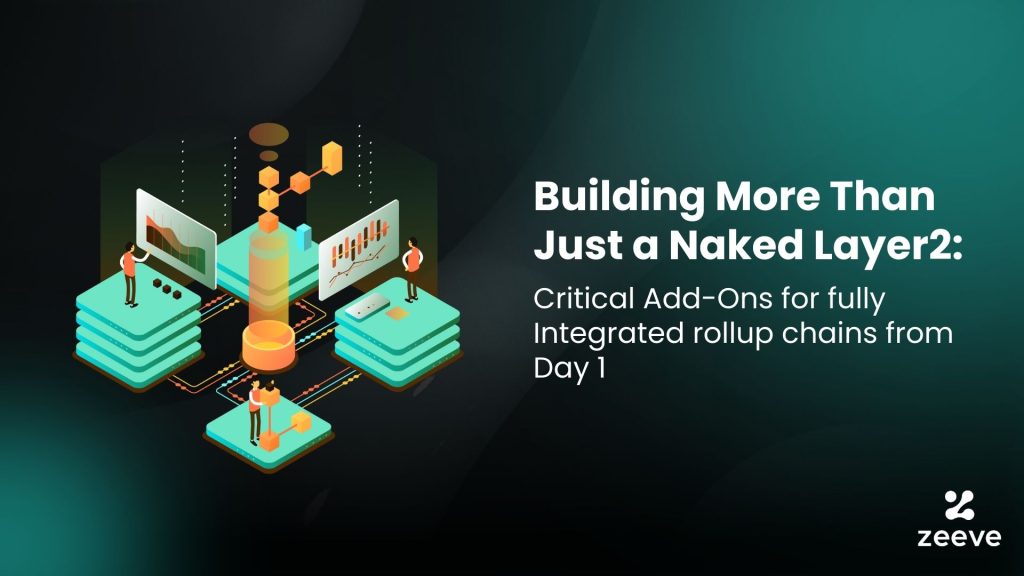Rollups have surely become the prime scaling solutions among all. But a standalone rollup might not be something you are looking for. There are many other fundamental components required that elevate a base rollup into a fully integrated, operational ecosystem from day one.
The rationale behind integrating them with the core rollup infrastructure is simple – creating an environment where decentralized applications can thrive without compromise. A barebones rollup might tick the box for scalability, but falls short in other aspects. However, when infused with these critical integrations, it morphs into a dynamic platform capable of supporting complex, secure, and user-centric blockchain applications.
This article aims to dissect the significance of each integration within the rollup ecosystem, showing how they collectively forge a pathway to a more accessible, secure, and versatile blockchain infrastructure.
Key Integrations To Make Your Rollup Efficient From Day 1
Must have essential rollup integrations for your roll-up chains;
- Decentralized Sequencers
As it is known that sequencers have a key role to play in a rollup ecosystem. They are designated with the task of receiving, organizing, executing transactions, and submitting transaction data into the block. However, if these sequencers choose to not respond to the rollup ecosystem, it can bring the rollup ecosystem to a standstill. So, if your rollup network is relying on a single centralized sequencer, unknowingly you are exposing your ecosystem to the risk of censorship or denial-of-service.
If centralized sequencers, or DACs are not something fits your need, the option is to go for decentralized sequencers.
But implementing a decentralized sequencer is not that easy and that’s where providers like Espresso and Radius are simplifying things. They have provided rollups the ease to deploy decentralized sequencers in the most simple way to secure: (i) Trustless Environment (ii) Immutability (iii) Censorship Resistance (iv) Resilience (v) Reduced Intermediaries for the rollup environment from day 1.
- Indexers Protocols
When you are developing your rollup solution, it would be handling an ocean of data. So, if you have any queries, the rollup environment should be built in such a way that it can quickly give you the response for your queries. Indexer protocols are the compass steering your rollup ship. They help get those information available that are non-trivial and not easily accessible.
For example, if you want to know within a rollup ecosystem who’s holding the majority of the X NFTs that are exploding in the ecosystem in a short span of time. There’s no way to find that out other than going through the entire rollup transactions and manually reading them along. Imagine if you have to do likewise with millions of other transactions in the rollup environment. This process is exhausting and impractical when querying millions of questions daily. However, you want to provide seamless transparency to the users, nonetheless. So, integrating indexer protocols with your rollups ends up as inevitable for helping your rollup end up as user-friendly for the users.
Indexers protocols like the Graph can help you make your rollup increasingly friendlier from the standpoint of user experience. They can help extract essential information from your rollup in a flash for users and developers uplifting their rollup experience.
- Account Abstraction Services
While using a roll-up, the experience should be as simple as traditional finance. However, traditional rollups have been only used as a mere scaling alternative with no added perks. But when modularity in the form of account abstraction is introduced to your rollup environment, it will not only uplift the user experience but also secure the ecosystem extensively.
For context, if you are simply using a naked rollup chain, you cannot define your own logic into the smart-contract to perform a function. There will be no payment on-ramp, no simplified login using email, biometric or passwords.
For example, if you want to give a superior gaming experience to your user where they can trigger a session from where they need not have to communicate with their EOAs time and again, you cannot do that when you have deployed a naked roll-up that only provides scalability. You can’t easily make the transactions gasless.
However, if you are going for a completely modular rollup having account abstraction features, you can program the smart-contract accordingly to perform the function discussed above. Biconomy, Halliday, Alchemy provides an account abstraction SDK that you can integrate with your rollup chain from day 1 to provide superior UX to the community active on your rollups.
- Data Availability Layer
If you are using a traditional rollup that uses the base chain for settlement, consensus and DA, it would lead to unnecessary competition for the block space on L1 which might lead to congestion, impacting scalability and network fees . As a result, a separate DA layer becomes an essential rollup integration, if you are seeking better control in regards to accessibility, transparency and data immutability.
Furthermore, in comparison to what Ethereum charges for acting as a DA layer, a separate DA layer like Celestia or Near is 8000x much cheaper with the trade-off of simple interaction. Hence, an undoubtedly cost-efficient DA layer that can be equally distributed among different layer is way more advanced and a rational choice than relying on the base L1 layer, which is being used for settlement and consensus for the rollup environment.
- Decentralized Oracles
A rollup with no add-ons like an oracle network interconnecting with other rollup environments could be catastrophic for the greater good of the ecosystem. How? Price discrepancies could be exploited in an unethical manner. For example, the Compound Protocol experienced $96.4 million financial fraud due to data unavailability with other partner networks. Decentralized oracles continuously feed the most updated data to all the interconnected chains with the Oracle Network. Hence, they avert such instances from occurring. In addition to this, these oracles also act as an underlying protective layer for the rollup ecosystem by establishing an oracle governance that observes all the happenings around different rollup chains and records their last state root.
Hence, if any malicious actor intends to trigger double spends, the Oracle governance provides all the necessary details that would allow the chain not to fork completely rather trigger an event reversal. Decentralized oracles provide that advantage where disputes can be easily resolved without disrupting the entire rollup ecosystem. Solutions like Chainlink and RedStone take cognizance of the last state root of the rollup to allow event mediation instead of forking the entire chain.
- Interoperability Protocols
When you speak of a $1 T or $5 T economy moving to blockchains, it cannot happen when blockchains are operating as separate islands of their own. A typical Rollups-as-a-Service ecosystem should be bridged extensively with other rollup chains with a squad level DA layer observing all the events across chains and providing a verifiable cost-effective Zk proof to trigger exchange of assets among various rollup networks.
Interoperability protocols like LayerZero, Axelar, Hyperchain use mailbox messaging and Decentralized Verifier Network (DVN) that provides all the information to the rollup partner networks using an Omni Chain Fungible Token (OFT) Standard that tracks and updates all the balances across numerous rollup chains to achieve that; thereby, allowing seamless interoperability among the larger rollup ecosystem. For rollups to remain highly communicative with their partner ecosystem, they must be able to pass on information in the cost effective manner that these protocols have ensured.
When you are deploying your rollup ecosystem, choosing to remain only scalable and not interoperable might result in users churning from your chain to switch to more advanced modular networks. Interoperability protocols like Router, Axelar, Hyperlane and LayerZero provide that trade-off to your rollup chain so that they remain communicable and interoperable from the day 1 of the integration with other partner roll-up chains within the ecosystem.
- Other Rollups Integrations
Other rollup integrations like explorers are a must have for your rollup solution because they provide all the vital details of the rollups to keep them in sync with traditional L1s that are built on the ethos of transparency. TraceHawk is one of the finest block explorer powered by Zeeve.
Apart from this, NFT marketplace integration with Rarible, MEV extraction tool Shutter, Authentication tool Particle Network, and MPC wallet infra, many such more are specific integrations that might required based on needs.
These are the essential roll-up integration must-haves that you should be adding to your roll-up ecosystem if you are planning to build anything beyond just a naked rollup L2 chain.

Build Your Complete Modular Rollup Chain With Zeeve RaaS
Developers creating their ZK Rollups or Optimistic Rollups with the Zeeve Rollups-as-a-service can seamlessly tap into the benefits of the above-mentioned rollup integration.
Be it any framework, zkSync ZK Stack, Arbitrum Orbit, Polygon CDK or OP Stack, these tools can work seamlessly through pluggable integration available on the platform.
Zeeve RaaS ensures an enterprise Service Level Agreement (SLA) and a commitment to 99.9% uptime, with ISO, SOC2 TypeII and GDPR compliance.
If you are planning to launch your own rollups, don’t hesitate to reach out to us. Our experts can help you identify the best infrastructure suitable for your use case. Schedule a call today!























